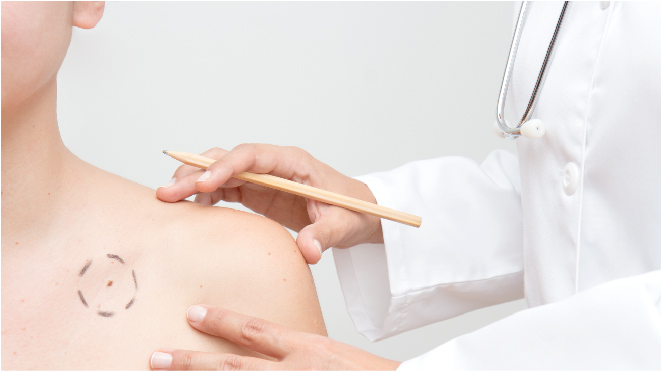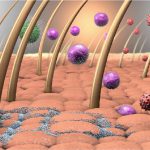Depending on the tissue or organ where the cancer begins, there are around 200 types of cancers and these are called primary cancers, skin cancers are cancers that start in the skin cells. Read more about skin cancer here.
What are precancerous conditions?
Conditions that have the potential to develop into cancers are termed precancerous conditions. For skin cancers, the following are the major precancerous conditions or in this case, skin lesions. A skin lesion refers to an abnormal growth or appearance when compared to the skin around it, these can be present at birth or acquired over a person’s lifetime. The following are some skin lesions that can develop into skin cancer:
Actinic Keratosis:
Actinic keratosis is a rough scaly patch on the skin that develops due to prolonged exposure to sunlight as a result of damage due to ultraviolet radiation. It is found primarily on areas exposed to the sun such as your face, lips, ears, hands, forearms, scalp or neck.
Anyone can develop actinic keratosis but is more likely in people over the age of 40 and living in sunny climates. Frequent or intense sunburns can indicate that the person is likely to get actinic keratosis. If treated early, the condition can completely disappear or removed before it develops into skin cancer. In cases that it does develop into skin cancer, it usually progresses to squamous cell carcinoma, which is not life threatening in itself either.
Actinic Cheilitis:
Actinic cheilitis is an inflammation on the lip that is caused by long term sun exposure. It usually appears in the form of chapped lips that can turn white or scaly. It starts with usually dry cracking lips that develops into red or white patches, usually on the lower lip.
It usually appears in people over the age of 40 and is more common in men than it is in women. It is also more likely in people with fairer skin tones and living in sunny climates. People that get skin burns or freckle easily are more prone to AC. If untreated, this condition can develop into skin cancer, usually squamous cell carcinoma. Read more about types of skin cancer here.
Cutaneous Horns:
A cutaneous horn is a type of lesion or growth that can develop into cancer. It is made up of keratin, a protein that is present in the top layer of the skin. It is called a horn as it as the growth protrudes out of the skin and may resemble a cone, a spike or a horn. They usually appear on the face, hands, ears, head, chest or arms, areas of the body that are more exposed to the sun.
It is more likely in older people and is more common in the ages of 60 to 70 years. Both men and women can develop cutaneous horns though men are more likely to develop skin cancer because of this condition. People with fair or light skin tones are at more risk. Cutaneous horns are not contagious though it can cause pain or inflammation.
Dysplastic Nevi (Atypical Moles):
Dysplastic nevus or atypical mole is as the name suggests, an unusual looking mole and is usually benign. These may resemble melanoma and higher the number of atypical moles, more is the risk of developing skin cancer. These can occur anywhere on the body but are usually seen in the areas exposed to the sun. If untreated, these may develop into skin cancers, usually melanomas.
An atypical mole may be bigger than a normal mole, usually more than 5 mm wide, it can have a mixture of different colours ranging from pink to brown. It is usually flat, and can have a smooth, scaly or slightly pebbly texture and can have irregular edges that may fade into surrounding skin.
When are moles indicative of skin cancer?
New spots or moles on the skin or changes in the existing ones can suggest skin cancers. The ABCDE rule covers the signs to lookout for in case of moles:
- A (Asymmetry): One half of the mole or the birthmark is different from the other
- B (Border): The edges of the mole are irregular, ragged, notched or blurred
- C (Colour): The colour is not uniform throughout the mole
- D (Diameter): The spot is larger than 6 mm (though it is possible for it to be smaller too sometimes)
- E (Evolving or elevating): The mole is changing in size, shape or colour




